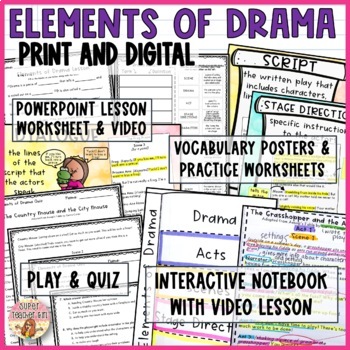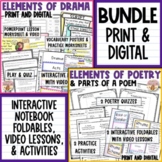Elements of Drama UNIT Interactive Notebook Video Lessons & Comprehension
- Zip
What educators are saying
Also included in
- Do you need engaging lessons and scaffolded activities to teach the elements of DRAMA and POETRY? Your students will easily grasp these concepts with video lessons, interactive notebook activities, practice activities, and quizzes.This DRAMA UNIT includes:20-Slide Animated PowerPoint Lesson- PerfectPrice $11.20Original Price $16.25Save $5.05
Description
Teaching drama doesn’t have to be stressful with this PRINT & DIGITAL unit! Step 1) Students watch an introductory video lesson while completing a handout. Step 2) Students watch a video lesson walking them through the interactive notebook activity. Step 3) Students complete an Elements of Drama vocabulary matching activity. Step 4) Students will be so familiar with these terms that they will ace the drama comprehension quiz. Step 5) You keep your sanity!
This DRAMA UNIT includes:
- 20-Slide Animated PowerPoint Lesson- Perfect for introducing students to the elements of drama with a familiar story and characters.
- Google Slides Version of the lesson is included but is not animated.
- Video Lesson- Students can watch the introductory lesson during stations or at home. A video link (YouTube) is included for easy access.
- Student Intro Worksheet- Students will stay engaged with the lesson by filling in the blanks as they follow along. (Google Slides version is included.) Students can watch the video lesson in one tab and complete the worksheet in another (or on paper).
- Interactive Notebook Activity with Video Lesson- Teaches students the elements of drama by walking through a snippet of The Ant and the Grasshopper. A video link (YouTube) is included as well as a QR code on the interactive notebook worksheet. (There is no digital version of the worksheet).
- Drama Term Matching Worksheet- A cut-and-paste activity where students will match 10 key terms and definitions. Google Slides version can be completed digitally with drag-and-drop.
- 4-Page Drama Comprehension Quiz with an original script for Town Mouse & City Mouse. Google Slides version can be completed digitally. A short instructional video is included to show students how to highlight answers digitally.
- Vocabulary Posters for each term & a Googles Slides version is included.
Terms Include:
Drama
Act
Scene/Setting
Script
Stage Directions
Props
Narrator
Playwright
Dialogue
*Characters (identifying how the name precedes the character’s lines in the script)
*Characters (identifying characterization through their words and actions)
Check out the Interactive Notebook Video Lesson
Check out the Intro to Drama Lesson Preview
*The 4th and 5th-grade TEKS specifically mention “Character Tags” and I contacted TEA about this term. They admit that it is an ambiguous term and that there is no specific way to teach it since it is not a term typically used for drama. They assured me that it could be taught as character names and/or characterization but that it really shouldn’t be called “character tags”. I’ve chosen to teach it both ways in these lessons.






